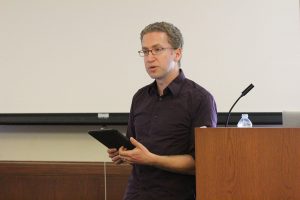Visiting professor speaks on race and state power
Keith Feldman, an assistant professor of ethnic studies at UC Berkeley, spoke to students on the intersection between race, culture, knowledge and state power at Doheny Memorial Library on Monday. The event, titled “Patterns of Life: Race, Relationality, U.S. Imperial Culture,” was sponsored by the Departments of French & Italian, American Studies & Ethnicity and Comparative Literature and the Middle East Studies Program.

Julia Erickson | Daily Trojan
Power play · UC Berkeley professor Keith Feldman argued that media and art forms are shaping the country’s relations with the Middle East.
Feldman began the event by showing images of Laurie Anderson’s modern art exhibition Habeas Corpus, a commentary on the conditions of Guantanamo Bay.
The theme of utilizing campaign-driven social media, works of installation art and photography to render the violence of the War on Terror continued to crop up throughout Feldman’s lecture, a phenomenon Feldman termed “critical awareness media.”
“They often utilize the performance of proximate embodiment as a way to elicit an ethic of intersubjective relationality that might other be foreclosed by processes of racialization,” Feldman said. “A rhetoric of sentiment often augers a sense of interiority for both perpetrators and victims alike, and this binary is often operationalized.”
Feldman also addressed the recent refugee crisis, citing The New York Times’ recent use of virtual reality to drop the reader within a Syrian refugee camp as a way of forging an empathetic connection between people lacking proximity.
“The form seeks to close a perspective gap between reader and subject … But rather than stage a form of substitution, the displaced promises recognition through immersion,” Feldman said. “It’s still completely mediated, but the encompassing aesthetic of present materializes in an approximation of shared place that calibrates the promise of empathy.”
Feldman’s first book, A Shadow Over Palestine: The Imperial Life of Race in America, explores U.S. racial and imperialist relations. He is currently in the process of writing his second book, Patterns of Life: Raciality, Visuality, Global War.
He recently edited a forum on blackness and relationality, and has had numerous articles published in New Centennial Review, Al Jazeera and Palestine Square.
As the floor opened up for discussion, Feldman argued that the concept of using media and art forms to bring awareness was not a novel one, but that such mediums were shaping U.S.-Middle East relations and changing the dynamic between the so-called victims and perpetrators.
“There’s a sympathetic Arab or Muslim subject that’s being constituted in this work … These are depictions of a liberal subjectivity that can be recognizable and hence empathized with,” Feldman said. “Being cognizant of how our critical conversations around Islamophobia and anti-Muslim racism were cohering in certain kinds of ways precluded us from seeing them in a non-vilified manner.”
Ariel Reyes, a graduate student majoring in comparative media and culture, was surprised to consider the men behind the machines — those who were manning the U.S. drone strikes.
“The whole notion of perceiving the drone operator and seeing it from his viewpoint was interesting,” Reyes said. “We usually hear in the media of the reaction from a drone, portrayed as violent images, but the people operating them, they’re working a 9-5 job.”
Cord-Heinrich Plinke, a Ph.D. student in comparative studies of literature and culture, appreciated how Feldman’s lecture opened up a variety of perspectives and drew people who seemingly did not have much in common.
“The audience was comprised of [people of] different backgrounds, various departments, which was interesting and unexpected,” Plinke said. “I thought the focus on visuality was interesting. It really changed the perspective for me because the rest was quite abstract.”
